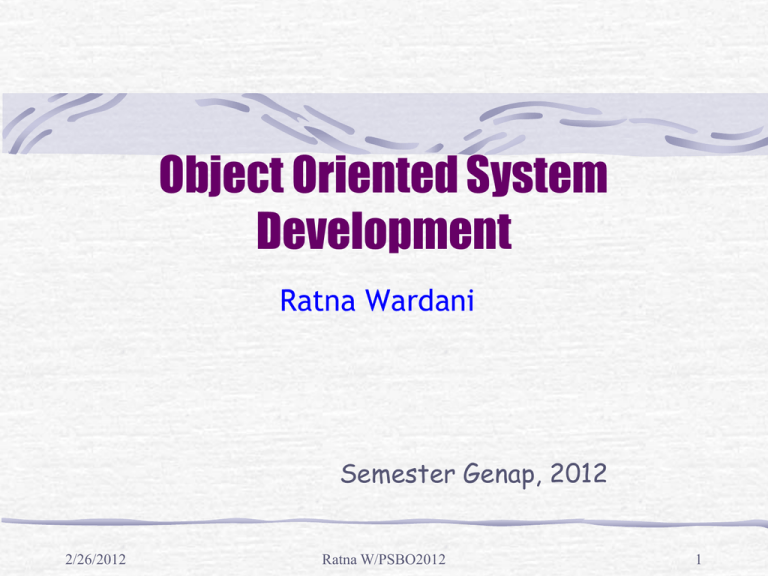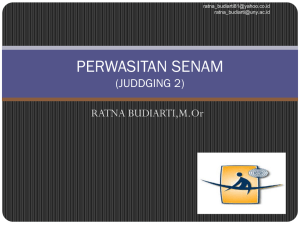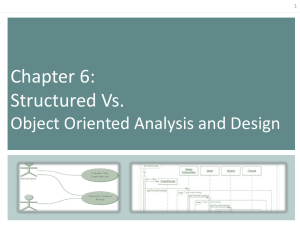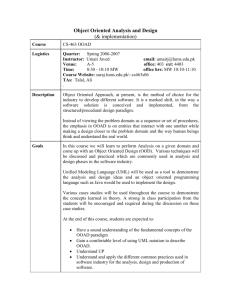Object Oriented System Development Ratna Wardani Semester Genap, 2012
advertisement

Object Oriented System Development Ratna Wardani Semester Genap, 2012 2/26/2012 Ratna W/PSBO2012 1 About This Course It shows how to apply OOAD technique to analyze and develop systems.. It gives you an overview of the Rational Unify Process It’s not make you an experts in OOAD 2/26/2012 Ratna W/PSBO2012 2 Course Contact Point Ping me directly IM: nanairianto Email: nanawardani@gmail.com Twitter: @nanawardani You can get an info of my availability as well FB: ratna.wardani Plurk: eyna11 2/26/2012 Ratna W/PSBO2012 3 Outline Introduction to Object Oriented Analysis and Design (OOAD) Concept Methods OOAD in Software Engineering Rational Unified Process SAD vs OOAD Discussion 2/26/2012 Ratna W/PSBO2012 4 Concept: What is OOAD Based on objects rather than data or processes. Object: a structure encapsulating attributes and behaviors of a real world entity 2/26/2012 Ratna W/PSBO2012 5 Concept: What is OOAD Object class: a logical grouping of objects sharing the same attributes and behaviors. Inheritance: hierarchical arrangement of classes enable subclasses to inherit properties of superclasses. 2/26/2012 Ratna W/PSBO2012 6 What is “Object Oriented” Simplicity thru selfcontained objects Complexity thru integration Interchangeability thru frameworks 2/26/2012 Ratna W/PSBO2012 7 Object Oriented Method A technique for system modeling A technique to manage complexity inherent in analysis, design, and implementation For the analysis and design of system Provide integrated view of hardware and software Provide a methodology for system development 2/26/2012 Ratna W/PSBO2012 8 Object Oriented Method : How “Using object-orientation as a base, we model a system as a number of objects that interacts.” 2/26/2012 Ratna W/PSBO2012 9 OO Method : The Benefits A system which is designed and modelled using an object-oriented technology is: Easy to understand Directly related to reality - semantic gap Natural partitioning of the problem More flexible and resilient to change Systems can be developed more rapidly and at a lower cost 2/26/2012 Ratna W/PSBO2012 10 Object Oriented Method Object-Oriented Design (OOD) - Booch (1983), pioneering but not quite scalable Object-Oriented System Analysis (OOSA) - Shlaer & Mellor (1988), essentially information analysis based on data modelling Object-Oriented Analysis (OOA) - Coad & Yourdon (1991), a method for developing OO system model 2/26/2012 Ratna W/PSBO2012 11 Object Oriented Method Object Modelling Technique (OMT) Rumbaugh et al. (1991), entity/relationship modeling with extension to model classes, inheritance and behavior Hierarchical Object-Oriented Design (HOOD) - ESA (1989), architectural design for Ada code 2/26/2012 Ratna W/PSBO2012 12 Object Oriented Method Jacobson Use Case - Jacobson et al. (1992), requirement modeling, analysis and design; also known as OOSE Unified Modelling Language (UML) Booch, Rumbaugh, Jacobson (1997/2000), a method that provides a united OO approach to system development 2/26/2012 Ratna W/PSBO2012 13 OOAD in SE Process A process tells us Who does What and When.. OOAD shows us How Provide a structure for design artifacts: Scope/vision Use case Diagram Conceptual design Uses Case Phisycal Design Sequence and Class Diagrams Implementation Component/Deployment Diagrams 2/26/2012 Ratna W/PSBO2012 14 Rational Unified Process (RUP) An object oriented systems development methodology. RUP establishes four phase of development: inception, elaboration, construction, and transition. Each phase is organized into a number of separate iterations. 2/26/2012 Ratna W/PSBO2012 15 Rational Unified Process (RUP) 2/26/2012 Ratna W/PSBO2012 16 Rational Unified Process (RUP) Inception establish the business case for the system and delimit the project scope identify all external entities with which the system will interact (actors) and define the nature of this interaction at a high-level. Elaboration to analyze the problem domain, establish a sound architectural foundation, develop the project plan, and eliminate the highest risk elements of the project 2/26/2012 Ratna W/PSBO2012 17 Rational Unified Process (RUP) Construction all remaining components and application features are developed and integrated into the product, and all features are thoroughly tested Transition transition the software product to the user community develop new releases correct some problems, finish the features that were postponed. 2/26/2012 Ratna W/PSBO2012 18 SAD vs OOAD Structured Object-Oriented Methodology SDLC Iterative/Incremental Focus Processs Objects Risk High Low Reuse Low High Maturity Mature and widespread Emerging (1997) Suitable for Well-defined projects with stable user requirements Risky large projects with changing user requirements 2/26/2012 Ratna W/PSBO2012 19 SAD vs OOAD Phase Structured Object-Oriented Analysis Structuring Requirements Requirement Engineering • • • • DFDs Structured English Decision Table / Tree ER Analysis • Use Case Model (find Uses Cases, Flow of Events, Activity Diagram) • Object Model • Find Classes & class relations • Object Interaction: Sequence & collaboration Diagram, State Machine Diagram, • 2/26/2012 Ratna W/PSBO2012 Object to ER Mapping 20 SAD vs OOAD Phase Structured Object-Oriented Design • Physical DB design • DB design • (DB normalization) • Design elements • Design system Architecture • GUI Design • Design classes: Checking The Model, Combine Classes, Splitting • (forms & reports) Classes, Eliminate Classes • Design components • GUI design 2/26/2012 Ratna W/PSBO2012 21 Discussion Explore what is the different between SAD and OOAD. Give your explanation..! OOAD is (relatively) new in system development. Give a brief history of system development ! 2/26/2012 Ratna W/PSBO2012 22





